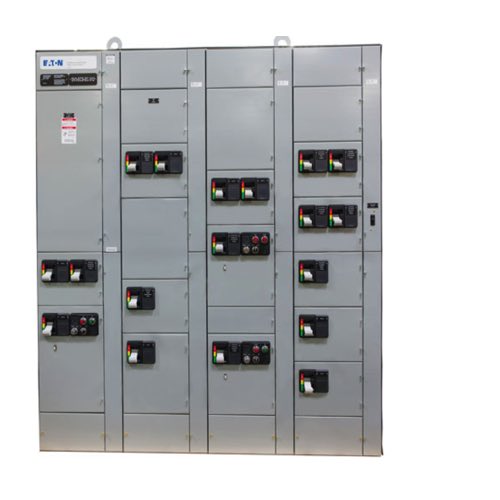Motor Control Centers

Motor control centers (MCCs) are centralized electrical systems designed to manage, protect, and distribute power to multiple electric motors in industrial and commercial environments. RSP Supply offers a selection of MCCs from Eaton that provide an organized, enclosed solution for housing motor starters, circuit breakers, switches, and related control components. These systems streamline motor power distribution while improving safety, reliability, and system efficiency.
Modern MCCs often incorporate additional components such as soft starters, variable frequency drives, fuses, and motor protection devices. These elements help safeguard motors from short circuits, overloads, and abnormal operating conditions. By consolidating motor control equipment into a single enclosure, MCCs simplify installation, reduce wiring complexity, and improve accessibility for maintenance and troubleshooting.
Advanced motor control centers can also be configured with intelligent technologies that support enhanced monitoring, predictive maintenance, and energy management. Integrated motor controllers, push buttons, indicator lights, and communication-capable devices provide greater visibility into system performance. Vertical and horizontal bus systems within the enclosure ensure reliable power distribution, while combination starters and protection devices help maintain consistent motor operation under varying load conditions.
FAQs
Q: What is a motor control center (MCC)?
A motor control center is an enclosed assembly that houses motor control units such as starters, breakers, and switches to centrally manage and protect multiple motors.
Q: What components are typically found in an MCC?
Common components include motor starters, circuit breakers, disconnect switches, fuses, soft starters, variable frequency drives, and motor protection devices.
Q: Why are MCCs used in industrial applications?
MCCs provide organized power distribution, improved safety, simplified maintenance, and reliable control of multiple motors from a centralized location.
Q: Can MCCs support advanced monitoring and control?
Yes, modern MCCs can integrate intelligent motor controllers, indicators, and communication technologies for enhanced monitoring and predictive maintenance.
Q: How do MCC bus systems work?
MCCs use vertical and horizontal bus systems to distribute power efficiently throughout the enclosure, ensuring reliable connections to each motor control unit.
Why Buy Motor Control Centers from RSP Supply
RSP Supply offers motor control centers from trusted manufacturers like Eaton, designed to meet the demands of industrial motor control and power distribution. Our MCC solutions provide reliable protection, organized system layouts, and flexibility for modern automation requirements. Customers rely on RSP Supply for dependable industrial components, technical expertise, and solutions that support long-term operational performance.

